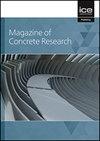Effects a simplified numerical model for temperature profiles of early age concrete
IF 1.8
4区 工程技术
Q3 CONSTRUCTION & BUILDING TECHNOLOGY
引用次数: 0
Abstract
The issue of early age concrete cracking is challenging and relies on the state of concrete soon after it is placed in the formwork. The concrete state is a function of the strains associated with thermal and other dilatations and the level of in-situ strength. Both strain and strength primarily require information on the temperature-time history of the concrete element. For larger elements, the thermal history varies significantly across the thickness and the concrete material itself acts as a confinement for discrete elements. Due to complexity of the issue, designers currently rely on mock tests and/or finite element modelling mostly for structures that are deemed ‘important’. Both approaches are costly and time consuming. It is, therefore, important to have a robust yet simple model to estimate the temperature variation experienced by the concrete elements. The proposed spreadsheet-based model reported in this paper aims to provide a rapid estimate of the temperature profiles within a hydrating concrete element. The model uses the concept of effective thickness and the revised heat compensation technique. It is validated based on measured temperature development of a rectangular section concrete block. Further, the proposed model is successfully compared with output from finite element software TNO Diana.早龄期混凝土温度曲线简化数值模型的影响
早期混凝土开裂问题具有挑战性,并且依赖于混凝土在放入模板后不久的状态。混凝土状态是与热膨胀和其他膨胀以及原位强度水平相关的应变的函数。应变和强度主要都需要混凝土构件的温度-时间历史信息。对于较大的元素,热历史在厚度上变化很大,混凝土材料本身对离散元素起限制作用。由于问题的复杂性,设计师目前主要依赖于模拟测试和/或有限元建模,主要用于被认为“重要”的结构。这两种方法都是昂贵和耗时的。因此,重要的是要有一个稳健而简单的模型来估计混凝土构件所经历的温度变化。本文提出的基于电子表格的模型旨在提供水化混凝土元件内温度分布的快速估计。该模型采用了有效厚度的概念和修正的热补偿技术。通过实测矩形截面混凝土砌块的温度变化,对该方法进行了验证。最后,将该模型与有限元软件TNO Diana的输出结果进行了比较。
本文章由计算机程序翻译,如有差异,请以英文原文为准。
求助全文
约1分钟内获得全文
求助全文
来源期刊

Magazine of Concrete Research
工程技术-材料科学:综合
CiteScore
4.60
自引率
11.10%
发文量
102
审稿时长
5 months
期刊介绍:
For concrete and other cementitious derivatives to be developed further, we need to understand the use of alternative hydraulically active materials used in combination with plain Portland Cement, sustainability and durability issues. Both fundamental and best practice issues need to be addressed.
Magazine of Concrete Research covers every aspect of concrete manufacture and behaviour from performance and evaluation of constituent materials to mix design, testing, durability, structural analysis and composite construction.
 求助内容:
求助内容: 应助结果提醒方式:
应助结果提醒方式:


